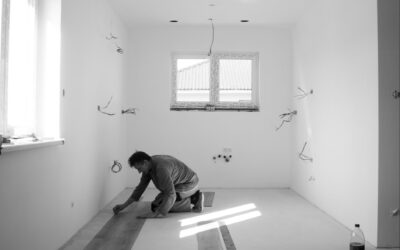So, you want to replace some of the floors in your home and you are looking for a hard solution as opposed to carpet. However, you’ve looked briefly at vinyl and laminate flooring but are struggling to see the difference.
This is common as the two flooring types look similar and are both available in planks. However, when you start to delve closer, you see the differences and in this article, I explain the difference between vinyl and laminate flooring so you can choose the best option for your house!
Overview of Vinyl Flooring
Luxury vinyl flooring or LVT is an increasingly popular flooring type that is available in planks or tiles and closely mimics traditional hard floors such as wood, stone, and concrete. This is a type of multi-layered flooring option that uses vinyl as its core material.
Overview of Laminate Flooring
Laminate flooring is supplied as planks and is also a type of multi-layered flooring that mimics traditional hardwood, stone, and concrete floors.
Where LVT flooring uses vinyl as the main component, laminate flooring has a clear aluminium oxide wear layer and a core made from compressed wood fibres. You can check out this insightful look into laminate flooring for more info.
Difference Between Vinyl and Laminate Flooring
We have a basic understanding of the two flooring types, but apart from the materials, there still doesn’t seem to be much difference! Therefore, below, I break down the different components of these flooring types and give a direct comparison.
Composition and Material Differences
The main difference between vinyl and laminate flooring is the material composition. LVT flooring is made from various layers of vinyl including a wear layer, a protective layer, a photographic layer, and core vinyl layers. It can have built-in backing or underlayment too.
In contrast, laminate flooring has a top wear layer made from aluminium oxide, a photographic layer, a core made from compressed wood fibres, and backing or built-in underlayment.
Appearance and Style Variations
Historically, laminate flooring is seen as the slightly better-looking flooring option however modern LVT flooring looks incredible. Both aesthetic layers are textured and depending on their thickness can be embossed to feel like actual wood or stone flooring for example.
They are both available in a myriad of colours, patterns, and textures and there isn’t much difference in terms of availability. Both LVT and laminate can mimic wood, stone, and concrete and are available in colours such as brown, beige, and grey in various shades.
Durability, Longevity, and Maintenance
For maintenance and durability, vinyl flooring is the better choice and this is because of the waterproofing. Vinyl flooring is typically waterproof, whereas laminate flooring may only be water-resistant and sometimes not even that.
This means that water will soak into laminate flooring and cause warping and damage and you should generally avoid mopping laminate floors.
Longevity depends on the thickness of the vinyl and laminate is more subject to damage and this can greatly reduce the lifespan of your flooring:
- Thicker vinyl flooring: Up to 25 years lifespan.
- Thinner vinyl flooring: 10-15 years lifespan.
- Well-maintained laminate: 15-25 years lifespan.
- Poorly maintained laminate: 5-10 years lifespan.
Room Suitability and Applications
Both of these flooring options look fantastic in a range of rooms, but you have to be careful.
Because LVT is generally waterproof, it can be used in rooms with a higher moisture content and where splashes can occur such as kitchens and bathrooms. In contrast, laminate is not as suitable for these rooms and I would actively avoid using laminate in a bathroom. Kitchen use is OK, but just avoid mopping the floor.
Both floor types cope well with higher foot traffic and work great in hallways for example. Another consideration is the warmth and padding as compared to carpet, these flooring types have poorer soundproofing and can be colder.
Cost Comparison
The cost implications are also incredibly important and in most instances, laminate flooring is the slightly cheaper option. I stress the word slightly though as the difference is minimal. This is due to the additional quality and waterproofing features of the laminate and the vinyl core.
The main thing is that both flooring types are much cheaper than actual hard options like hardwood, stone, or concrete.
Which Flooring Type is the Better Option?
I hope you can now see the difference between vinyl and laminate flooring and have a clear understanding of their qualities. But which is the better option? This can be circumstantial, but in most instances, LVT presents the more cost-effective option.
Vinyl flooring offers better longevity, improved durability and waterproofing, and any difference in visual quality is barely noticeable. The cost difference is small too, but because of the improved longevity, paying more for vinyl flooring still makes for a better long-term flooring investment.










